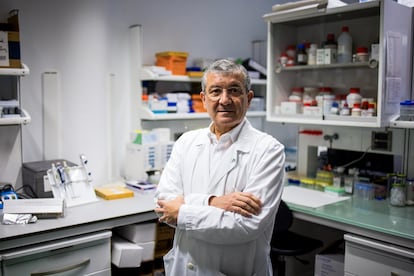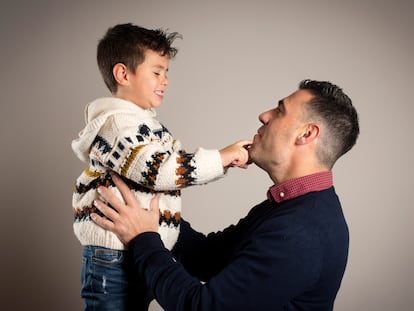Rafael López, oncologist: ‘With a blood test we expect to be able to identify the weaknesses of almost all tumors’
On the front lines of cancer research for 40 years, this expert believes liquid biopsies will change the way patients are treated and their prognosis

Every step in the scientific fight against cancer is a race against time: there are crazy cells that multiply unchecked, and oncologists look for ways to get ahead of them in order to detect them as soon as possible, treat them, or find out if any stragglers have colonized other parts of the body. Time is of the essence, and the scientific community knows it. That is why it has focused a good part of its efforts into developing tools to accurately monitor the behavior of tumors and anticipate the latters’ plans. One way is through a liquid biopsy, which detects biological traces of the tumor in blood or other fluids.
Great hopes are being placed on this technique, admits Rafael López, 65, head of oncology at the Santiago de Compostela University Hospital Complex (CHUS) in northwestern Spain and scientific coordinator of a symposium on liquid biopsy that was recently held in Santiago de Compostela: “It is an important innovation because it makes us change the way we treat and give a prognosis to patients,” he says.
The doctor, who has been on the front lines for four decades in consultation rooms, seeing cancer up close, says he is “lucky.” During this time he has seen oncology move into “another world”: from little more than chemotherapy to treat a handful of tumors with a dismal prognosis, to having a complex therapeutic arsenal that has managed to double cancer survival. And liquid biopsies are just one more piece in the machinery of this new world that is being built: in practice, for the patient, this blood test is like a blood sample for a conventional analysis, but it can reveal invaluable information about a tumor.
López, who has also just been appointed president of the Spanish Association for Cancer Research (ASEICA), admits that with a liquid biopsy there are still technical and economic limitations before all the potential predicted by experts can crystallize into clinical practice. But he is optimistic. Solving these obstacles is only a matter of time, says the oncologist, who spoke to EL PAÍS by videoconference from Santiago shortly before the symposium.
Question. Where is the liquid biopsy most widely used?
Answer. It is a technique that is still somewhere between the practical use and research phases. And in this transition, Spain is not being particularly agile in incorporating innovation. It is more established in advanced lung cancer, to look for biomarkers that indicate whether a patient will respond to a treatment or not. It is also being used in colon and rectal cancer to see if [the tumor] will respond to certain drugs or not. And in third place, it is used for breast cancer. But we have more than 200 tumors, and within each cancer there is early detection, the diagnosis of initial disease, that of intermediate disease and that of advanced disease. And in each circumstance there are some uses for liquid biopsies.
Q. What are the major obstacles to bringing liquid biopsy into clinical practice?
A. It is a combination of situations. One of them is economic: they are expensive tests. Another limitation is that they are very complex tests and we need to understand how they are done, why they should be ordered and how they should be interpreted. And then, how to apply them. In scientific terms, the clinical utility remains to be demonstrated in many circumstances.
Q. What can a liquid biopsy tell us about a tumor?
A. It is complementary to the tissue biopsy. When we do a tissue biopsy we only see the tissue we take out, but the tissue right next to it may be different. On the other hand, the liquid biopsy collects everything. With the experimental ultrasensitive techniques that are being investigated, it will be possible to collect more than 95% of the information about the tumor. And if you have 100 mutations, you cannot address them all, you will have to prioritize, and the ones that interest us are the driver mutations [those that lead to tumor proliferation]. Those are the ones that really interest us and we want to know how much weight they have because the tumor is also changing and, perhaps, at a given moment it has one or two driver mutations and, if we attack them, they will disappear but others appear that we have to identify and attack as well. This is a continuous evolutionary game. With the liquid biopsy, through a blood test, we expect to be able to identify the weaknesses of almost all tumors.
The future will involve following the patient’s tumor through liquid biopsy, to know if it is there and, if it is, what weaknesses it has; and, if it changes, to anticipate it
Q. What do you hope to see in the next few years with liquid biopsies? What do you think you will be able to do with them?
A. With liquid biopsy tests we will be able to detect much smaller tumors and the treatment that is started at that time will be much more effective than the one started now. We will also be able to see if the treatment completely eliminated the tumor or not in order to give a prognosis and, above all, to quickly be able to apply another treatment when the tumors are smaller and fewer. And, in addition, we will be able to find out what treatment we have to apply. The future will involve following the patient’s tumor through a liquid biopsy, to know if it is there and, if it is, what weaknesses it has; and, if it changes, to anticipate it.
Q. You have assumed the presidency of ASEICA at a time of paradigm shift in cancer. For example, there are more and more cases emerging in young people. What is happening?
A. We are missing a lot of things, and one of them is why we now have cancer in younger people, even in people without bad habits such as smoking. We are missing something and we need to increase research, share everything and work collaboratively. We are now realizing that cancer shows up in younger people based on epidemiological records, which are records that were taken five years ago. We have to change things to be able to have the data in real time.
Q. You have been on the front lines of cancer research for 40 years. What surprises you most about the behavior of tumor cells?
A. They are very clever and try to escape from all the traps we set for them. And, in addition, they continually give us unpleasant surprises. They are as clever as, or cleverer than, the rest of the body and that drives us crazy. And it was very difficult for us to understand that because for many centuries we thought that cancer was a static thing and everything was the same. But no: tumors are different and constantly changing.
Sign up for our weekly newsletter to get more English-language news coverage from EL PAÍS USA Edition
Tu suscripción se está usando en otro dispositivo
¿Quieres añadir otro usuario a tu suscripción?
Si continúas leyendo en este dispositivo, no se podrá leer en el otro.
FlechaTu suscripción se está usando en otro dispositivo y solo puedes acceder a EL PAÍS desde un dispositivo a la vez.
Si quieres compartir tu cuenta, cambia tu suscripción a la modalidad Premium, así podrás añadir otro usuario. Cada uno accederá con su propia cuenta de email, lo que os permitirá personalizar vuestra experiencia en EL PAÍS.
¿Tienes una suscripción de empresa? Accede aquí para contratar más cuentas.
En el caso de no saber quién está usando tu cuenta, te recomendamos cambiar tu contraseña aquí.
Si decides continuar compartiendo tu cuenta, este mensaje se mostrará en tu dispositivo y en el de la otra persona que está usando tu cuenta de forma indefinida, afectando a tu experiencia de lectura. Puedes consultar aquí los términos y condiciones de la suscripción digital.
More information
Archived In
Últimas noticias
ChatGPT fails the test: This is how it endangers the lives of minors
The late consecration of women artists in their 90s
The Florida Keys tourist paradise is besieged by immigration agents: ‘We’ve never seen anything like this’
The latest scam on WhatsApp behind the legal dream: using immigration status as bait
Most viewed
- Families demand repatriation of bodies of Colombians who died in Ukraine: ‘This war is a slaughterhouse for foreigners’
- The low-cost creative revolution: How technology is making art accessible to everyone
- Liset Menéndez de la Prida, neuroscientist: ‘It’s not normal to constantly seek pleasure; it’s important to be bored, to be calm’
- Christian Louboutin: ‘Young people don’t want to be like their parents. And if their parents wear sneakers, they’re going to look for something else’
- ‘El Limones’ and the growing union disguise of Mexican organized crime











































